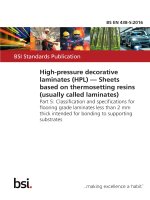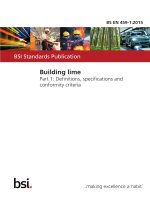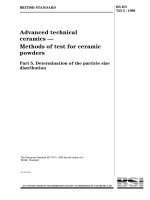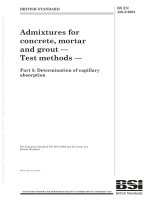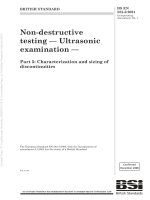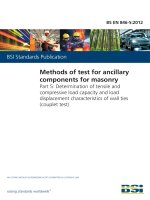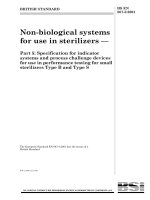Bsi bs en 13201 5 2015
Bạn đang xem bản rút gọn của tài liệu. Xem và tải ngay bản đầy đủ của tài liệu tại đây (1.52 MB, 32 trang )
BS EN 13201-5:2015
BSI Standards Publication
Road lighting
Part 5: Energy performance indicators
BS EN 13201-5:2015
BRITISH STANDARD
National foreword
This British Standard is the UK implementation of EN 13201-5:2015.
The UK participation in its preparation was entrusted to Technical
Committee EL/1/2, Road lighting.
A list of organizations represented on this committee can be
obtained on request to its secretary.
This publication does not purport to include all the necessary
provisions of a contract. Users are responsible for its correct
application.
© The British Standards Institution 2016.
Published by BSI Standards Limited 2016
ISBN 978 0 580 83197 3
ICS 93.080.40
Compliance with a British Standard cannot confer immunity from
legal obligations.
This British Standard was published under the authority of the
Standards Policy and Strategy Committee on 31 January 2016.
Amendments/corrigenda issued since publication
Date
Text affected
BS EN 13201-5:2015
EN 13201-5
EUROPEAN STANDARD
NORME EUROPÉENNE
EUROPÄISCHE NORM
December 2015
ICS 93.080.40
English Version
Road lighting - Part 5: Energy performance indicators
Éclairage public - Partie 5: Indicateurs de performance
énergétique
Straßenbeleuchtung - Teil 5:
Energieeffizienzindikatoren
This European Standard was approved by CEN on 6 June 2015.
CEN members are bound to comply with the CEN/CENELEC Internal Regulations which stipulate the conditions for giving this
European Standard the status of a national standard without any alteration. Up-to-date lists and bibliographical references
concerning such national standards may be obtained on application to the CEN-CENELEC Management Centre or to any CEN
member.
This European Standard exists in three official versions (English, French, German). A version in any other language made by
translation under the responsibility of a CEN member into its own language and notified to the CEN-CENELEC Management
Centre has the same status as the official versions.
CEN members are the national standards bodies of Austria, Belgium, Bulgaria, Croatia, Cyprus, Czech Republic, Denmark, Estonia,
Finland, Former Yugoslav Republic of Macedonia, France, Germany, Greece, Hungary, Iceland, Ireland, Italy, Latvia, Lithuania,
Luxembourg, Malta, Netherlands, Norway, Poland, Portugal, Romania, Slovakia, Slovenia, Spain, Sweden, Switzerland, Turkey and
United Kingdom.
EUROPEAN COMMITTEE FOR STANDARDIZATION
COMITÉ EUROPÉEN DE NORMALISATION
EUROPÄISCHES KOMITEE FÜR NORMUNG
CEN-CENELEC Management Centre: Avenue Marnix 17, B-1000 Brussels
© 2015 CEN
All rights of exploitation in any form and by any means reserved
worldwide for CEN national Members.
Ref. No. EN 13201-5:2015 E
BS EN 13201-5:2015
EN 13201-5:2015 (E)
Contents
Page
European foreword....................................................................................................................................................... 4
Introduction .................................................................................................................................................................... 5
1
Scope .................................................................................................................................................................... 6
2
Normative references .................................................................................................................................... 6
3
3.1
3.2
Terms, definitions, symbols and abbreviations ................................................................................... 6
Terms and definitions ................................................................................................................................... 6
Symbols and abbreviations ......................................................................................................................... 7
4
4.1
4.2
4.3
4.4
Power Density Indicator (PDI) ................................................................................................................... 9
Calculation of the power density indicator............................................................................................ 9
Average horizontal illuminance to be used for calculation of the power density
indicator ............................................................................................................................................................. 9
System power (P) to be used for calculation of the power density indicator ........................ 10
Area (A) to be used for calculation of the power density indicator ........................................... 11
5
Annual Energy Consumption Indicator (AECI) .................................................................................. 11
Annex A (informative) Examples of calculation and typical values of energy performance
indicators ........................................................................................................................................................ 13
A.1
Examples of operational profiles ........................................................................................................... 13
A.1.1 General ............................................................................................................................................................. 13
A.1.2 Full power operation .................................................................................................................................. 13
A.1.3 Multi-power operation ............................................................................................................................... 14
A.1.4 Operation with vehicle and presence detectors ............................................................................... 14
A.2
Example of calculation ............................................................................................................................... 15
A.3
Typical values of energy performance indicators ............................................................................ 16
A.3.1 General ............................................................................................................................................................. 16
A.3.2 Two-lane road for motorized traffic (road profile A) ..................................................................... 17
A.3.3 Road with mixed motorized and pedestrian traffic without sidewalks (road profile
B) ........................................................................................................................................................................ 18
A.3.4 Road and sidewalk on the side of lighting arrangement (road profile C) ............................... 19
A.3.5 Road and sidewalk on the opposite side to the lighting arrangement (road profile D) ..... 20
A.3.6 Road and two sidewalks on both sides (road profile E) ................................................................. 21
A.3.7 Road and two sidewalks on both sides separated from carriageway by grass strips
(road profile F) .............................................................................................................................................. 22
A.3.8 Typical values of AECI for different operational profiles .............................................................. 22
Annex B (informative) Installation luminous efficacy ................................................................................... 24
B.1
2
General ............................................................................................................................................................. 24
BS EN 13201-5:2015
EN 13201-5:2015 (E)
B.2
Calculation of the correction factor ....................................................................................................... 24
B.3
Calculation of the utilance ......................................................................................................................... 25
B.4
Calculation of the efficiency of luminaires .......................................................................................... 25
Annex C (informative) Lighting factor of an installation ............................................................................... 26
C.1
Installation lighting factor qinst ................................................................................................................ 26
C.2
Role of qinst in road lighting design aimed at energy saving .......................................................... 26
C.3
Typical values of qinst ................................................................................................................................... 26
Annex D (informative) Presentation of energy performance indicators ................................................ 27
Bibliography ................................................................................................................................................................. 28
3
BS EN 13201-5:2015
EN 13201-5:2015 (E)
European foreword
This document (EN 13201-5:2015) has been prepared by Technical Committee CEN/TC 169 “Light and
lighting”, the secretariat of which is held by DIN.
This European Standard shall be given the status of a national standard, either by publication of an
identical text or by endorsement, at the latest by June 2016 and conflicting national standards shall be
withdrawn at the latest by June 2016.
Attention is drawn to the possibility that some of the elements of this document may be the subject of
patent rights. CEN [and/or CENELEC] shall not be held responsible for identifying any or all such patent
rights.
EN 13201, Road lighting is a series of documents that consists of the following parts:
— Part 1: Guidelines on selection of lighting classes [Technical Report];
— Part 2: Performance requirements;
— Part 3: Calculation of performance;
— Part 4: Methods of measuring lighting performance;
— Part 5: Energy performance indicators [present document].
According to the CEN-CENELEC Internal Regulations, the national standards organizations of the
following countries are bound to implement this European Standard: Austria, Belgium, Bulgaria,
Croatia, Cyprus, Czech Republic, Denmark, Estonia, Finland, Former Yugoslav Republic of Macedonia,
France, Germany, Greece, Hungary, Iceland, Ireland, Italy, Latvia, Lithuania, Luxembourg, Malta,
Netherlands, Norway, Poland, Portugal, Romania, Slovakia, Slovenia, Spain, Sweden, Switzerland,
Turkey and the United Kingdom.
4
BS EN 13201-5:2015
EN 13201-5:2015 (E)
Introduction
The purpose of this European Standard is to define energy performance indicators for road lighting
installations. The standard introduces two metrics, the power density indicator (PDI) DP and the annual
energy consumption indicator (AECI) DE that should always be used together.
To quantify the potential savings obtainable from improved energy performance and reduced
environmental impact, it is essential to calculate both the power density indicator (DP) and the annual
energy consumption indicator (DE). In addition, the installation luminous efficacy (ηinst) can be used for
comparing the energy performances of alternative road lighting installations.
Careful choice of lighting class(es) during the design and specification phase will help to maximize
energy savings by ensuring only the necessary levels of illumination provided at the correct times and
for the minimum periods necessary. Additional guidance is given in the CEN/TR 13201-1 with regard to
the visual needs of road users, e.g. under varying traffic volumes during certain times of night or under
varying weather conditions.
During the design phase of a road lighting installation care should be taken to ensure that the design
criteria specified in EN 13201-2 are achieved but that excess overlighting is reduced to the minimum
technically obtainable. Overlighting can be minimized by the careful selection of the luminaire and light
source but the specified lighting class, the designed lighting point spacing and uniformity ratios are all
determining factors of the luminous flux emitted by the light source and thus the power of the light
source required. However, this precise luminous flux may not, in reality, exist. Where the luminous flux
of the light source is greater than that required the designer can by means of continuously variable
control gear, compensate for this effect by reducing the luminous flux of the light source to the required
level resulting in lower energy consumption. The same principles and control gear can be used to
compensate for changes in luminous flux emitted throughout the lifetime of the light sources.
The energy levels calculated using this standard should not be used as a direct input for the calculation
of the load on the electrical distribution system. Such calculations are normally based on the energy
requirement derived directly from the lighting and electrical design.
Examples of operational profiles and examples of calculation of the energy performance indicators are
provided in Annex A. Typical values of energy performance indicators are provided to illustrate the
energy performance of recent technological level of luminaires and installations.
Annex B introduces the installation luminous efficacy and its factors as a measure of the influence of
various light losses and other parameters.
Lighting factor of an installation, as introduced in Annex C, can be additionally used to characterize the
energy performance of road lighting installations independently on the lighting components used. Other
factors and parameters having influence to the energy performance, such as the maintenance factor
(see CIE 154), can be recognized but are not dealt with in this standard.
Recommendations on presentation of the energy performance indicators are provided in Annex D.
5
BS EN 13201-5:2015
EN 13201-5:2015 (E)
1 Scope
This part of the European Standard defines how to calculate the energy performance indicators for road
lighting installations using the calculated power density indicator (PDI) DP and the calculated annual
energy consumption indicator (AECI) DE. Power density indicator (DP) demonstrates the energy needed
for a road lighting installation, while it is fulfilling the relevant lighting requirements specified in
EN 13201-2. The annual energy consumption indicator (DE) determines the power consumption during
the year, even if the relevant lighting requirements change during the night or seasons.
These indicators may be used to compare the energy performance of different road lighting solutions
and technologies for the same road lighting project. The energy performance of road lighting systems
with different road geometries or different lighting requirements cannot be compared to each other
directly, as the energy performance is influenced by, amongst others, the geometry of the area to be lit,
as well as the lighting requirements. The power density indicator (DP) and annual energy consumption
indicator (DE) apply for all traffic areas covered by the series of lighting classes M, C and P as defined in
EN 13201-2.
2 Normative references
The following documents, in whole or in part, are normatively referenced in this document and are
indispensable for its application. For dated references, only the edition cited applies. For undated
references, the latest edition of the referenced document (including any amendments) applies.
EN 12665:2011, Light and lighting — Basic terms and criteria for specifying lighting requirements
EN 13201-2, Road lighting — Part 2: Performance requirements
EN 13201-3:2015, Road lighting — Part 3: Calculation of performance
3 Terms, definitions, symbols and abbreviations
3.1 Terms and definitions
For the purposes of this document, the terms and definitions given in EN 12665:2011 and the following
apply.
3.1.1
system power (of a lighting installation in a given state of operation)
P
total power of the road lighting installation needed to fulfil the required lighting classes as specified in
EN 13201-2 in all the relevant sub-areas, and to operate and control the lighting installation (unit: W)
3.1.2
power density indicator PDI (of a lighting installation in a given state of operation)
DP
value of the system power divided by the value of the product of the surface area to be lit and the
calculated maintained average illuminance value on this area according to EN 13201-3 (unit: W.lx-1.m-2)
6
BS EN 13201-5:2015
EN 13201-5:2015 (E)
3.1.3
annual energy consumption indicator AECI (of a lighting installation in a specific year)
DE
total electrical energy consumed by a lighting installation day and night throughout a specific year in
proportion to the total area to be illuminated by the lighting installation (unit: Wh.m-2)
3.1.4
installation luminous efficacy
ηinst
minimum luminous flux needed to provide the minimum lighting level for the specified area divided by
the total average power consumption of the lighting installation (unit: lm.W-1)
3.1.5
constant light output CLO (of a road lighting installation)
regulation of the road lighting installation aiming at providing a constant light output from the light
sources
Note 1 to entry:
This functionality aims to compensate for the light loss caused by ageing of the light sources.
3.1.6
installation lighting factor
qinst
dimensionless factor accounting for the relation of the calculated average maintained luminance of road
surface over the calculated average maintained horizontal illuminance on this surface and the average
luminance coefficient of the r-table adopted in luminance calculation
3.2 Symbols and abbreviations
Table 1 — Symbols and abbreviations
Symbol or
abbreviation
A
AFL
AFR
AR
AECI
CL
cop
CLO
DE
DP
E
EFL
EFR
Name or description
Unit
Area to be lit
m2
Area of the right sidewalk
m2
Area of the left sidewalk
Area of the carriageway
Annual Energy Consumption Indicator
Correction factor for luminance or hemispherical illuminance based lighting
designs
Lighting operation coefficient
Constant Light Output
Annual energy consumption indicator (AECI)
Power density indicator (PDI)
Average maintained horizontal illuminance
Calculated maintained illuminance on the left sidewalk
Calculated maintained illuminance on the right sidewalk
m2
m2
Wh.m-2
W.lx-1.m-2
lx
lx
lx
7
BS EN 13201-5:2015
EN 13201-5:2015 (E)
Symbol or
abbreviation
Name or description
Ehs
Hemispherical illuminance
lx
ER
Calculated maintained illuminance on the carriageway
lx
E min
EIR
fM
kred
L
Minimum required average illuminance
Edge Illuminance Ratio
Overall maintenance factor (MF) of the lighting installation
Reduction coefficient for the reduced level illumination
Lmin
Average maintained luminance
LOR
m
Light Output Ratio
MF
Maintenance Factor
n
nlp
P
Pad
PF
Pls
PR
PDI
RLO
qinst
Qo
t
tfull
tred
U
ΦA
Φls
ηinst
ηls
nlu
ηP
8
Minimum required average luminance
Unit
lx
-
cd.m-2
cd.m-2
Number of operation time periods for different levels of operational power P
-
Number of sub-areas to be lit
-
Number of light points associated with the lighting installation or the
representative section
-
System power of all the luminaires designed to lit the relevant area
W
System power of the luminaire designed for illumination of the sidewalk
W
Total active power of any devices not considered in the operational power P but
necessary for operation of the road lighting installation
Power of lamp(s) inside the luminaire
System power of the luminaire designed for illumination of the carriegeway
Power Density Indicator
Optical efficiency of luminaires (LOR) used in the lighting installation
Lighting factor of an installation
Average luminance coefficient
Duration of the operation time for a particular system power P over a year
Annual operation time of the full level illumination
Annual operation time of the reduced level illumination
Utilance of the lighting installation
Luminous flux reaching the area to be illuminated
Luminous flux emitted from the light source(s) in a luminaire
Installation luminous efficacy
Luminous efficacy of the light sources used in the installation
Number of luminaires considered in the calculation
Power efficiency of luminaires used in the lighting installation
W
W
W
-
sr-1
h
h
h
-
lm
lm
lm.W-1
lm.W-1
-
BS EN 13201-5:2015
EN 13201-5:2015 (E)
4 Power Density Indicator (PDI)
4.1 Calculation of the power density indicator
Power density indicator for an area divided into sub-areas for a given state of operation shall be
calculated with the following formula:
DP =
where
DP
P
E
Ai
n
n
P
∑( Ei ⋅ Ai )
i =1
(1)
is the power density indicator, W·lx-1·m-2;
is the system power of the lighting installation used to light the relevant areas (see 4.3), in W;
i
is the maintained average horizontal illuminance of the sub-area “i” determined in accordance with
4.2, in lx;
is the size of the sub-area “i” lit by the lighting installation, in m2;
is the number of sub-areas to be lit.
If the required lighting class changes during the night and/or through the seasons (for example
reductions in lighting class due to decreased traffic density, changes in the visual environment or other
relevant parameters), the power density (DP) should be calculated separately for each of the lighting
classes. Alternatively, where multiple lighting classes are used during the night or year the power
density (DP) may be calculated as an average over this period. The calculation shall clearly indicate the
assumptions used for calculation of the power density (DP) and how this value was evaluated.
Values of the power density indicator (DP) shall be always presented and used together with the annual
energy consumption indicator (DE) for assessment of the energy performance of a particular lighting
system.
4.2 Average horizontal illuminance to be used for calculation of the power density
indicator
For illuminance based lighting classes (C and P) the maintained average horizontal illuminance ( E ) to
be used for the power density (DP) calculation shall be calculated according to EN 13201-3.
For luminance based lighting classes (M) the maintained average horizontal illuminance ( E ) to be used
for the power density (DP) calculation shall be the average of illuminance values calculated on the same
grid of points which are used for the calculation of luminance in accordance with EN 13201-3.
For hemispherical illuminance based lighting classes (HS) the maintained average horizontal
illuminance ( E ) to be used for the power density (DP) calculation shall be the average of illuminance
values calculated on the same grid of points which are used for the calculation of hemispherical
illuminance in accordance with EN 13201-3.
Some lighting installations may be over lit in terms of significantly higher lighting levels than those
required or specified. When such over lighting occurs, it should be determined if this is as a result of
poor design or as an unavoidable consequence of other requirements. From an energy efficiency and
environmental perspective corrective action should be taken to minimize any over lighting.
9
BS EN 13201-5:2015
EN 13201-5:2015 (E)
From an energy efficiency and environmental perspective the calculated lighting level for any lighting
installation should not exceed the required lighting level of the next higher lighting class (or not exceed
the required lighting level by 50 % in case of the highest class) without considering other design
solutions.
4.3 System power (P) to be used for calculation of the power density indicator
The system power (P) shall be calculated from the sum of the operational power of the light sources,
control gear(s) and any other electrical device(s) (lighting point control unit(s), switch(es),
photoelectric cell(s), etc.) which are directly associated with the lighting of the area to be lit and
installed in order to operate or regulate the installation. The system power (P) should be calculated for
the complete lighting installation or the representative section used during the lighting design
according to the following formula:
=
P
nlp
∑P
k =1
where
P
Pk
Pad
k
+Pad
(2)
is the total system power of the lighting installation or its representative section, in W;
is the operational power of the ‘kth’ lighting point (light source, gear, any other device like lighting
point control unit, switch or photoelectric cell and component, which are associated with the lighting
point and necessary for its operation), in W;
is the total operational power of any devices not considered in Pk but necessary for the operation of
the road installation such as a remote switch or photoelectric cell, centralized luminous flux
controller or centralized management system, etc. in W.
Where the system power is calculated for a representative area the total operational power Pad should
be proportioned according to the number of luminaires used to illuminate the area over the total
number of luminaires supplied from the devices represented by Pad.
nlp
is the number of lighting points associated with the lighting installation or the representative section
whichever is used in the calculation.
If light sources (and other electrical devices) are operated on constant power, this power shall be used
when the system power (P) is calculated.
If the lighting class changes during the night and/or seasons (for example reduction in lighting class
during the night due to decreased traffic density, changes in the visual environment or other relevant
parameters), the system power (P) corresponding to the required lighting class in that period should be
calculated.
NOTE
PDI can be a single number for full-time constant power operation and for 100 % dimming level in
regulated systems, or it can represent different numbers for each considered state of operation. Annex A gives
examples of calculation and Annex D gives an example of the presentation of results.
Where the luminous flux output of the light source is varied to compensate for changes in luminous flux
output throughout lifetime of the light sources (for example the light sources use constant light output
(CLO) drivers), the average system power associated with these variations should be used for the
calculation of power density (DP).
If the calculation for the main lighting class is based on a single calculation for a section of the road, i. e.
for a typical arrangement and spacing, then the system power (P) calculation shall include the sum of
the power of all luminaires and the electrical device(s) related to luminaires, lighting points and
segments which are inside and on the edges of the calculation area relevant to this typical arrangement,
10
BS EN 13201-5:2015
EN 13201-5:2015 (E)
in accordance with EN 13201-3. Annex A shows some typical examples. The number of luminaires and
size of the area shall be relevant to each other.
If the calculation is performed for an irregular shaped area, the system power (P) calculation shall
include the sum of the power of each luminaire and the electrical device(s) related to luminaires,
lighting points and segments, which are needed to light the area.
The system power (P) should not include any power associated with devices which are not used to fulfil
the lighting function, even if they are connected to the same network. Typical examples are illuminated
advertisement and festive lighting.
4.4 Area (A) to be used for calculation of the power density indicator
The area used for calculation of the power density indicator (DP) shall be identical to the area used in
lighting design for lighting calculation of parameters according to EN 13201-2 and described in
EN 13201-3.
If the carriageway of a road is not surrounded by other areas (for example another carriageway,
footpath, cycle path or parking areas, etc., which have their own individual specified lighting
requirements) and Edge Illuminance Ratio (EIR) is calculated in accordance with EN 13201-2, the
surrounding areas used for calculating EIR are not included in the calculation of power density
indicator.
5 Annual Energy Consumption Indicator (AECI)
The annual electricity consumption of a road lighting installation depends on:
— the period of time for which lighting is provided,
— the lighting class specified by the relevant lighting standard for each lighting period,
— the efficiency of the lighting installation, when providing the necessary lighting for each period,
— the way the lighting management system follows the change in visual needs of road users,
— the parasitic energy consumption of lighting devices during the period when the lighting is not
needed.
For comparison and monitoring of the energy performance of a lighting installation, the energy
consumption indicator shall take into account the annual accumulated energy use of road lighting
illuminating the street or public area, however actual lighting needs may vary during the year because
of the following reasons:
— seasonal variations of daylight / night time hours: this depends on the geographical location of the
area,
— changing weather conditions which influence perceived visual performance (i.e. dry or wet road
surface),
— changing traffic density on the street or public area during the night (i.e. different temporal pattern
of usage such as increased usage at “rush hour”) or following the fluctuation in social activity (i.e.
school terms, national holiday periods),
— changing functionality of the street or public area (i.e. roads are closed for a certain period or
turned to pedestrian areas in festive seasons).
11
BS EN 13201-5:2015
EN 13201-5:2015 (E)
Annual energy consumption indicator (AECI) shall be calculated with the following formula:
m
DE =
where
∑ ( Pj ⋅ t j )
j =1
A
DE
is the annual energy consumption indicator for a road lighting installation, in Wh.m-2;
tj
is the duration of jth period of operation profile when the power Pj is consumed, over a year, in h;
Pj
A
m
(3)
is the operational power associated with the jth period of operation, in W;
is the size of the area lit by the same lighting arrangement, in m2;
is the number of periods with different operational power Pj. m shall also consider the period over
which the quiescent power is consumed. This period would generally be the time when the lighting
is not operational, i.e. daylight hours and any night time period when the lighting is not lit.
If the light output of a light source is intended to be constant, but the power consumption of this light
source (or other electrical devices) varies in time (for example if constant light output (CLO) drivers are
used), the average power consumption over the anticipated lifetime shall be included in the calculation.
The calculation shall clearly indicate the lifetime assumptions used for calculation of the average
consumption and how this value was evaluated.
Annual energy consumption indicator (DE) shall be always presented and used together with the values
of the power density indicator (DP) for assessment of the energy performance of a particular lighting
system.
12
BS EN 13201-5:2015
EN 13201-5:2015 (E)
Annex A
(informative)
Examples of calculation and typical values of energy performance
indicators
A.1 Examples of operational profiles
A.1.1 General
Typical examples of daily operational profiles for road lighting are given below. Start time and end time
of operation change throughout the year and depend on the geographical latitude and local conditions.
It is advisable that the operation of artificial lighting is correlated with illuminance from daylight with
respect to the illuminance required for a particular lighting class according to EN 13201-2. In the
moment of sunset the illuminance level is considerably high but rapidly decreases. At sunrise the
situation is reversed.
Examples of operational profiles in this annex illustrate the daily course of lighting level. Power level
needed for the calculation of energy performance is associated with lighting levels depending on lamp
type, lamp power and other factors.
NOTE 1
This annex does not deal with particular relation between lighting level and power level.
NOTE 2
Parasitic power is not included in the operational profiles presented below.
For the calculation of AECI it is necessary to sum up daily operation hours for each of the lighting levels
throughout a whole year.
A.1.2 Full power operation
The profile in Figure A.1 is typical for lighting installations with simple switching devices like time
switchers or photosensors. Luminaires operate constantly at full power throughout the night time each
day.
Key
x
y
daily course of operation (h)
lighting level (%)
Figure A.1 — Full power operational profile
13
BS EN 13201-5:2015
EN 13201-5:2015 (E)
A.1.3 Multi-power operation
The multi-power profile (e.g. bi-power profile shown in Figure A.2) consist of two or more time periods
during the daily course when luminaires are operated at different power associated with different
lighting levels provided. Each of the lighting levels should be derived from lighting class according to
EN 13201-2.
Key
x
y
daily course of operation (h)
lighting level (%)
Figure A.2 — Bi-power operational profile
A.1.4 Operation with vehicle and presence detectors
If vehicle and/or presence detectors are used to control the lighting system, full power or multi-power
operational profiles are truncated by time periods when no traffic is sensed by the associate detectors
and luminaires operate at reduced levels. Figure A.3 shows an example of tri-power operational profile
for lighting control with detectors where at least a minimum lighting level is kept throughout the night
time. Peaks depicted in Figure A.3 depend on sensing and are not periodical. For calculation of AECI it is
necessary to assume for annual probability parameter for each of the lighting levels.
Key
x
y
14
daily course of operation (h)
lighting level (%)
Figure A.3 — Tri-power detector-driven operational profile
BS EN 13201-5:2015
EN 13201-5:2015 (E)
A.2 Example of calculation
Calculation of the energy performance indicators PDI (Clause 4) and AECI (Clause 5) is additionally
explained by means of an example depicted in Figure A.4.
A generic road profile consists of two lane carriageway with sidewalks on both sides and grass strips
separating them from carriageway.
Lighting poles are installed in the grass strip between the carriageway and the right sidewalk. Two
luminaires are installed per pole: Luminaire PR for illumination of the carriageway and the distant (left)
sidewalk partially also illuminates the right sidewalk. An additional luminaire PF is installed to support
the illumination of the right sidewalk and is, therefore, oriented towards this sidewalk. System power of
the luminaires PR and PF is the nominal power usually provided by luminaire manufacturer. If
calculation of energy performance is performed for a typical field between two consecutive lighting
poles according to EN 13201-3, system power PR and PF is included in calculation only once. If
calculation of energy performance is performed on the entire road length or its section longer than a
single field for photometric calculation, all luminaires associated with this road section are included.
Illuminated areas for the carriageway AR, left sidewalk AFL and right sidewalk AFR can be calculated from
the corresponding widths of road profile and the considered length of the installation (length of the
road, road section or spacing of luminaires). Illuminance of the carriageway ER, left sidewalk EFL and
right sidewalk EFR should be calculated in accordance with EN 13201-3. Areas of grass strips and strips
for calculation of the edge illuminance ratio are excluded from the calculation of energy performance
indicators.
For calculation of AECI it is necessary to take into account the lighting control profile applied to lighting
system as combination of reduction coefficient and annual operation time for each of the operational
regimes and probability of motion detection, if used. For example in case of the widely used bi-power
operation (see A.1.3) the total annual operation time is divided to the time of full operation tfull and the
time of reduced lighting level tred when the system power is lowered by the reduction coefficient kred.
Key
1
excluded from calculation
Figure A.4 — Situation and description of parameters for calculation of PDI and AECI as an
example
15
BS EN 13201-5:2015
EN 13201-5:2015 (E)
When applied to the situation in Figure A.4, and respecting the assumptions mentioned above,
Formulae (1) and (3) for the calculation of energy performance indicators become as follows:
DP =
PR + PF
EFL ⋅ AFL + ER ⋅ AR + EFR ⋅ AFR
DE =
where
( PR + PF ) ⋅ (tfull + kred ⋅ tred )
AFL + AR + AFR
PR
is the system power of the main luminaire in the lighting installation, in W;
AR
is the area of the carriageway, in m2;
PF
AFL
AFR
ER
EFL
EFR
tfull
tred
kred
(A.1)
(A.2)
is the system power of the auxiliary luminaire for illumination of the right sidewalk, in W;
is the area of the left sidewalk, in m2;
is the area of the right sidewalk, in m2;
is the calculated maintained illuminance on the road, in lx;
is the calculated maintained illuminance on the left sidewalk, in lx;
is the calculated maintained illuminance on the right sidewalk, in lx;
is the annual operation time of the full level illumination, in h;
is the annual operation time of the reduced level illumination, in h;
is the reduction coefficient for the reduced level illumination.
In Formula (A.2), for both luminaires the same lighting control profile is applied.
A.3 Typical values of energy performance indicators
A.3.1 General
Values of energy performance indicators PDI and AECI depend on many factors like the actual lighting
class, road profile arrangement, width of carriageway and sidewalks, type of the light source, quality of
optics and position of lamp in luminaires (through photometric data of luminaires), etc. In case of AECI,
switching and control profile may strongly affect the value of this indicator. Assuming the lighting
system is optimized to target photometric parameters, lighting designs may differ in energy
performance. The lower is the value of PDI and AECI, the better energy performance.
Values of energy performance indicators PDI and AECI presented in this annex are based on numerous
calculations of optimized lighting systems for different combinations of road profiles, lighting classes,
light source types and luminaires that are common in practice. The values should not be used as
benchmarks, they are intended to create an imagination on absolute values of the indicators and their
variation and to aid how to distinguish between more and less energy efficient solutions.
Assumptions taken into for sample calculations are as follows:
— width of sidewalks and grass strips, where applicable, equals to 2 m;
— maintenance factor is set to 0,80 for all types of lamps and luminaires;
16
BS EN 13201-5:2015
EN 13201-5:2015 (E)
— for road reflection properties the R3 table is considered;
— mounting height is optimized within the range 5 m to 12 m (step: whole numbers);
— spacing of lighting poles is optimized and sought between 20 m to 60 m (step: 1 m);
— arm overhang is ranged from 0 m to 2 m with the (step: 0,5 m);
— luminaires are not tilted;
— annual operation time 4 000 h at full power.
Arrangement of the lighting system is generally single-sided and for some situations with wider
carriegeway an opposite arrangement is selected. For each calculation, the lighting system geometry is
optimized with preference given to the spacing in order to enlarge the illuminated area as much as
possible and to have thus the energy performance indicators as low as possible. Mounting height and
arm length affects to the indicators only indirectly.
Luminaires used in calculations cover the possible options. Low-cost or sophisticated luminaires
incorporate reflecting diffuser or high-quality smooth or faceted reflectors, respectively. Lamp types
comprise ellipsoidal and tubular high-pressure sodium lamps, mercury lamps, metal halide lamps and
LEDs of different wattages. Lamp position in the luminaire, where adjustable, is optimized and not
taken as an option.
NOTE
Calculations are based on lighting products (luminaires) available in Q1/2014.
A.3.2 Two-lane road for motorized traffic (road profile A)
Table A.1 — Typical values of the Power Density Indicator DP in mW.lx-1.m-2 for road profile A
Lighting
class
Width of
carriageway
m
M1
7
M2
M3
M4
M5
M6
Lamp type
Mercury
7
100
7
84
10
8
85
83
6
103
6
89
7
7
5
4
7
90
86
97
116
85
Metal
halide
Sodium
elliptical
Sodium
tubular
42
43
31 - 32
51
43
45
50
42
47
60
30
34
41
48
37
40
40
41 - 47
47
53
34 - 41
31 - 40
30 - 33
34 - 38
40 - 44
34 - 42
38 - 45
41 - 51
53
65
45 - 49
LED
25 - 32
24 - 27
25 - 27
27
23 - 25
25 - 28
23
24
28
38
46
20 - 27
17
BS EN 13201-5:2015
EN 13201-5:2015 (E)
Table A.2 — Typical values of the Annual Energy Consumption Indicator DE in kWh.m-2
for road profile A
Lighting
class
Width of
carriageway
Mercury
Metal
halide
7
10,8
4,6
8
6,0
m
M1
7
M2
10
M3
7
6
M4
7
7
6
M5
6,0
6,0
7,0
5,0
3,2
3,4
5
3,6 - 4,0
7
1,9
4
M6
Lamp type
4,1
5,0
Sodium
elliptical
3,4
3,0
3,6
2,8 - 3,1
3,1
2,3 - 2,5
1,0
2,0
3,4
3,9
0,9
1,2
Sodium
tubular
4,0 - 5,3
3,0 - 3,8
2,3
1,6
3,2 - 4,2
3,0
2,2 - 2,4
3,2
2,7 - 2,8
1,7
1,5
2,5 - 2,6
1,8 - 2,4
1,1 - 1,6
1,2 - 1,7
1,5 - 1,8
1,7 - 2,3
0,6
LED
0,2 - 1,2
2,4 - 2,5
1,6
1,5
1,6
1,1
0,8
0,9
1,0
1,3
0,4 - 0,5
A.3.3 Road with mixed motorized and pedestrian traffic without sidewalks (road profile
B)
Table A.3 — Typical values of the Power Density Indicator DP in mW.lx-1.m-2 for road profile B
Lighting
class
Width of
carriageway
m
C3
C5
18
10
7
Lamp type
Mercury
Metal
halide
Sodium
elliptical
Sodium
tubular
92
51
39 - 45
35 - 41
29
60
44 - 53
98
6
103
6
107
7
5
95
110 - 125
44
57
36
43
43
48
69
LED
32
18 - 23
43
25 - 28
50 - 60
31
53 - 59
24
27
41
BS EN 13201-5:2015
EN 13201-5:2015 (E)
Table A.4 — Typical values of the Annual Energy Consumption Indicator DE in kWh.m-2
for road profile B
Lighting
class
Width of
carriageway
m
10
C3
7
6
7
C5
6
5
Lamp type
Mercury
Metal
halide
Sodium
elliptical
5,6
3,2
2,6 - 3,1
0,9
1,8
6,0
6,3
3,0
3,3
3,8
2,7
3,8
1,1
1,4
Sodium
tubular
LED
3,1
1,9 – 2,0
1,1 - 1,4
3,0
2,6
1,6 - 1,8
2,1
2,2 - 2,6
1,3 - 1,6
1,6 - 1,8
1,8 - 1,9
1,5 - 1,6
0,8
1,0
1,3
A.3.4 Road and sidewalk on the side of lighting arrangement (road profile C)
Table A.5 — Typical values of the Power Density Indicator DP in mW.lx-1.m-2 for road profile C
Lighting
class
Width of
carriageway
m
M3/P3
7
M5/P5
7
M4/P4
7
Lamp type
Mercury
Metal
halide
Sodium
elliptical
Sodium
tubular
73
50
35 - 38
30 - 34
68
71
38
25
33
39
LED
30 - 43
20 - 21
33 - 37
21
20
Table A.6 — Typical values of the Annual Energy Consumption Indicator DE in kWh.m-2
for road profile C
Lighting
class
Width of
carriageway
m
M3/P3
7
M5/P5
7
M4/P4
7
Lamp type
Mercury
Metal
halide
Sodium
elliptical
Sodium
tubular
LED
4,0
2,4
1,8 - 1,9
1,5 - 1,8
0,9
4,7
2,5
2,8
0,7
2,2 - 2,4
1,3
2,0
0,9 - 1,2
1,1
0,6
19
BS EN 13201-5:2015
EN 13201-5:2015 (E)
A.3.5 Road and sidewalk on the opposite side to the lighting arrangement (road profile
D)
Table A.7 — Typical values of the Power Density Indicator DP in mW.lx-1.m-2 for road profile D
Lighting
class
Width of
carriageway
m
M3/P3
7
M5/P5
7
M4/P4
7
Lamp type
Mercury
Metal
halide
Sodium
elliptical
Sodium
tubular
LED
78
48
35 - 40
27 - 35
19
73
74
41
24
34 - 35
39
32
32 - 38
20
20
Table A.8 — Typical values of the Annual Energy Consumption Indicator DE in kWh.m-2
for road profile D
Lighting
class
Width of
carriageway
m
M3/P3
7
M5/P5
7
M4/P4
20
7
Lamp type
Mercury
Metal
halide
Sodium
elliptical
Sodium
tubular
LED
4,0
2,4
1,8 - 1,9
1,4 - 1,8
0,9
4,7
2,5
2,8
0,7
2,2 - 2,4
1,3
2,0
0,9 - 1,2
1,2
0,6
BS EN 13201-5:2015
EN 13201-5:2015 (E)
A.3.6 Road and two sidewalks on both sides (road profile E)
Table A.9 — Typical values of the Power Density Indicator DP in mW.lx-1.m-2 for road profile E
Lighting
class
Width of
carriageway
m
M3/P3
7
M5/P5
7
M4/P4
7
Lamp type
Mercury
Metal
halide
Sodium
elliptical
Sodium
tubular
65
41
33 - 34
26 - 28
61
63
34
22
29
33
LED
24 - 33
17 - 18
28 - 32
17
17
Table A.10 — Typical values of the Annual Energy Consumption Indicator DE in kWh.m-2
for road profile E
Lighting
class
Width of
carriageway
m
M3/P3
7
M5/P5
7
M4/P4
7
Lamp type
Mercury
Metal
halide
Sodium
elliptical
Sodium
tubular
LED
3,2
2,0
1,5
1,2 - 1,5
0,7
3,8
2,0
2,3
0,6
1,8 – 2,0
1,0
1,6
0,7 - 1
1,0
0,5
21
BS EN 13201-5:2015
EN 13201-5:2015 (E)
A.3.7 Road and two sidewalks on both sides separated from carriageway by grass strips
(road profile F)
Table A.11 — Typical values of the Power Density Indicator DP in mW.lx-1.m-2 for road profile F
Lighting
class
Width of
carriageway
m
M3/P3
7
M5/P5
7
M4/P4
7
Lamp type
Mercury
Metal
halide
Sodium
elliptical
Sodium
tubular
LED
71
45
34 - 36
28 - 32
23
76
70
40
25
34
37
27 - 33
31 - 35
25
22
Table A.12 — Typical values of the Annual Energy Consumption Indicator DE in kWh.m-2
for road profile F
Lighting
class
Width of
carriageway
m
M3/P3
7
M5/P5
7
M4/P4
7
Lamp type
Mercury
Metal
halide
Sodium
elliptical
3,2
2,0
1,5
4,5
2,0
2,6
0,6
Sodium
tubular
LED
1,2 - 1,5
1,0
2,0
1,6 - 1,9
1,0
0,8 – 1,0
A.3.8 Typical values of AECI for different operational profiles
1,3
0,6
Typical values of AECI presented in A.3.2 to A.3.7 apply to full power operational profile (see A.1.2) with
annual operation time 4 000 h. To consider different operational profiles it is usually sufficient to
combine the annual operation times of individual lighting levels with the associated system power and
the detection probability (in systems with detectors) into a single lighting operation coefficient cop. This
coefficient can be used to multiply the AECI for full power operation to obtain the value of AECI for
actual operational profile.
Table A.13 shows typical values of the lighting operation coefficient cop for different operational profiles
under these assumptions:
— Full power: 4 000 h operation at full power P;
22
BS EN 13201-5:2015
EN 13201-5:2015 (E)
— Bi-power: 2 175 h at full power P and 1 825 h at reduced power 0,7⋅P with lighting level reduced to
50 %;
— Tri-power: 2 175 h of bi-level lighting control between 100 % and 60 % of the system power with
detection probability of 80 % and 1 825 h of reduced bi-level lighting control between 20 % and
60 % of system power with detection probability of 20 %.
Table A.13 — Typical values of the lighting operation coefficient cop in % for different
operational profiles
Operational profile
cop
%
Flat full power
100,0
Tri-power with detectors
62,8
Bi-power
86,3
23
